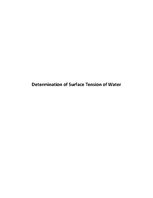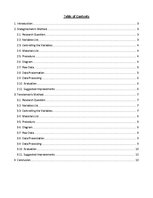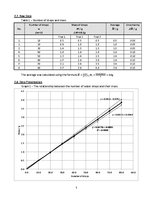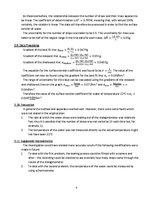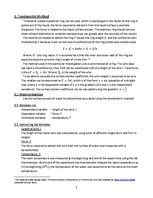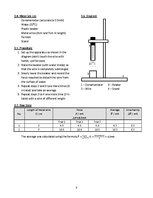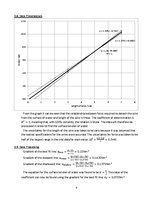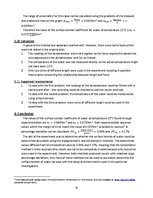| Nr. | Chapter | Page. |
| 1. | Introduction | 3 |
| 2. | Stalagmometric Method | 3 |
| 2.1. | Research Question | 3 |
| 2.2. | Variables List | 3 |
| 2.3. | Controlling the Variables | 4 |
| 2.4. | Materials List | 4 |
| 2.5. | Procedure | 4 |
| 2.6. | Diagram | 4 |
| 2.7. | Raw Data | 5 |
| 2.8. | Data Presentation | 5 |
| 2.9. | Data Processing | 6 |
| 2.10. | Evaluation | 6 |
| 2.11. | Suggested Improvements | 6 |
| 3. | Tensiometric Method | 7 |
| 3.1. | Research Question | 7 |
| 3.2. | Variables List | 7 |
| 3.3. | Controlling the Variables | 7 |
| 3.4. | Materials List | 8 |
| 3.5. | Procedure | 8 |
| 3.6. | Diagram | 8 |
| 3.7. | Raw Data | 8 |
| 3.8. | Data Presentation | 9 |
| 3.9. | Data Processing | 9 |
| 3.10. | Evaluation | 10 |
| 3.11. | Suggested Improvements | 10 |
| 4. | Conclusion | 10 |
3.10. Evaluation
In general the method and apparatus worked well. However, there were some faults which were not stated in the original plan:
1. The readings of the dynamometer were hard register as the force required to detach the wire appeared on the dynamometer only for an instant.
2. The temperature of the water was not measured directly so the actual temperature might not have been 22°C.
3. Only two wires of different length were used in the experiment resulting in possible inaccuracies concerning the relationship between length and force.
3.11. Suggested Improvements
1. To deal with the first problem, the readings of the dynamometer could be filmed with a camera and after – the recording could be checked to see the results precisely.
2. To deal with the second problem, the temperature of the water could be measured by using a thermometer.
3. To deal with the third problem, more wires of different length could be used in the experiment.
4. Conclusion
The values of the surface tension coefficient of water at temperature 22°C found through experimentation are …
Laboratorijas darbs fizikā (angliski): Ūdens virsmas spraiguma noteikšana.
Pdf formāts.

